Sixties
City presents
a wide-ranging series of
articles on all aspects of the Sixties, penned by the creator of the iconic
60s music paper Mersey
Beat
|
Sixties
City presents
a wide-ranging series of
articles on all aspects of the Sixties, penned by the creator of the iconic
60s music paper Mersey
Beat
|
|||||
|
|
Fonda and Vadim “All the women I’ve married or lived with had three things in common. They were actresses, they were beautiful and they dyed their hair blonde" - Roger Vadim. ‘Angelique, Le Marquise Des Anges’ was one of a series of best-selling French novels about an 18th Century heroine. Producer Frank Cosnes wanted Jane Fonda for the role and asked director Roger Vadim to contact her. Jane’s agent sent him a cable: “Miss Fonda will never film with Roger Vadim". Vadim had earned a reputation as a Svengali after discovering and marrying Brigitte Bardot and turning her into a star. He also discovered and married Annette Stroyberg, another BB-type actress – and starred her in the controversial ‘Les Liaisons Dangereuses’ and ‘El Mourir de Plaisir’ (based on Sheridan Le Fanu’s vampire tale, ‘Carmilla’). She didn’t achieve the fame of Bardot, although Vadim’s next discovery, a blonde 18-year-old Catherine Deneuve did become a major star, but although she bore his child, they didn’t get married. All this had created a press image which presented him as some sort of a monster. He was to say, “Jane believed in my reputation as a diabolical magician who, unlike the alchemists, transformed precious metal into lead, roses into thistles". The two first met briefly in the winter of 1957 and Jane said, “I’d heard things about him then that would curl your hair. That he was sadistic, vicious, cynical, perverted…a manipulator of women". Jane decided to leave America for Europe and moved to France to appear in the Rene Clement film ‘Les Felins'. That was when she was labelled ‘La BB Americaine’ by the French press. The label would become far more relevant when she began to be moulded by Bardot’s former husband Vadim, who said, “When she left Hollywood it was because she wanted to make a name on her own. She was a little starlet, the daughter of Henry Fonda. Some journalists compared her with Brigitte Bardot and she hated it. She came to France to make a name of her own. That was very courageous and typical of Jane". On being tagged ‘The American Bardot’, Jane remarked, “I’ve a lot of respect for Brigitte Bardot, but I don’t think I’m like her at all, and in any case, I prefer being myself". When ‘Les Felins (Joy House)’ was released, the major magazine Samedi et Dimanche observed, “The major revelation is Jane Fonda, ‘the American BB’, as Melinda. Her French is surprisingly good and her sex appeal is estimable. She has the potential to become a sex symbol in the tradition of Bardot or Monroe and, if she collaborates with Vadim, the results will be interesting". The initial meeting between the two in 1957 had been at Maxim’s where Jane was dining with Vadim’s best friend Christian Marquand. Vadim was there with his new wife Annette Stroyberg, who was pregnant at the time. He slipped a note to Marquand, who read it, screwed it up and threw it away. Jane picked it up and read it. It said, “Your friend has swollen ankles". When they were to meet again six years later, both their attitudes toward each other were different. She admitted that she’d never given him a chance when he’d initially approached her about a film role. She had a meeting with him at the Beverly Hills Hotel and when she returned to France, Vadim wanted her to star in a remake of ‘La Ronde’, a classic French film of 1954. He arranged a meeting at the home of her agent Olga Horstig and was to say, “For the second time in my life I was to be the victim of that strange disease, love at first sight". Jane agreed to star in ‘La Ronde’ and their relationship took on a more passionate note. Vadim decided to educate and mould her, encouraging her to read more books, classics by authors such as Gorky and Malreaux. They travelled Europe together, visiting places such as the red light district in Amsterdam. They even went to Moscow where Jane underwent a radical transformation of attitude in regard to Russia and its people. Vadim was responsible for the beginning of her political awareness. She moved into his flat with him during the making of La ‘Ronde'. He said, “I told Jane that I am incapable of making love to one woman all my life. ‘If I have a sex adventure', I said, ‘I will not lie to you – but one thing I promise you – it will not be important. I could have a mistress. Also I will not behave in public in such a way as to embarrass you". He was also to say of Jane, “Like all the women I have been involved with, she had a vulnerability. Nothing is more attractive than vulnerability in a woman. She wants to be beautiful but is not sure that she is. She wants to be happy but manages always to be unhappy. Jane always thought that to be happy you must build walls to protect yourself from unhappiness. If I taught her anything it was to be more of herself, not to be afraid". |
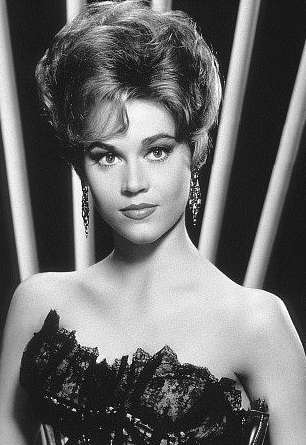 |
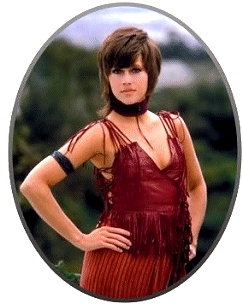 |
They
planned to make a film together called ‘Love’, but didn’t. Instead, the
next project was to be ‘La Curee’, based on an Emile Zola novel. This was
the subject of more controversy, probably with Vadim’s manipulation. In
the film, called ‘The Game Is Over’ in English, there is a ten-second scene
in a Turkish bath in which Jane is naked. At the time it was quite daring
for a major actress to reveal her breasts on film. The set had to be cleared,
but a photographer was hidden in the sound stage rafters and his photographs
appeared in ‘Playboy'. She sued.
Her lawyers said, “She had withheld from the public glare her nude personal
likeness and refused to permit any photography which used the exposed portion
of her body". She lost the case. Roger and Jane were married at the Dunes Hotel, Las Vegas on 14th August 1965. Peter Fonda and his wife Susan were in attendance, along with Roger’s mother, Mme Antoinette Ardiouze and Christian Marquand and his wife. Peter played guitar and there was also a five-piece orchestra of girl violinists in skin-tight blue dresses. Jane signed the register as Lady Jane Seymour Brokaw Fonda Plemiannikov. They were remarried on 18th May 1967 because the Las Vegas marriage was invalid in France. The next film was their famous collaboration ‘Barbarella'. Vadim said, “It looks more like a Brigitte Bardot movie, it is true. Sex is there, but not graphic sex. It is fun. People have completely forgotten that Jane became Jane Fonda through some other movies that helped her before ‘Barbarella'. All people remember is ‘Barbarella’ because ‘Barbarella’ looks more like a Bardot movie in a certain way, but it was just one of the movies that Jane could do". Time magazine wrote, “Comic-strip buffs, science-fiction fans and admirers of the human mammae will get a run for their money in ‘Barbarella’ and will probably provide ‘Barbarella’ with enough money for a run. Other moviegoers need take no notice. The only breakthroughs in the husband-and-wife collaboration of actress Jane Fonda and director Roger Vadim are made by Miss Fonda’s shapely torso through an assortment of body stockings". An intriguing opening scene provided the first striptease in space as the captivating space agent Barbarella is first seen covered from head to toe in a space suit which she slowly peels off while floating weightless. Although she appeared completely nude, she only agreed to do so with the proviso that portions of her private anatomy would be covered by the title credits. She wasn’t satisfied with the result and she made him re-film the scene. Her next film with Vadim was ‘Histoires Extraordinaires (Spirits of the Dead)’ in 1967, an anthology film based on four Edgar Allen Poe tales, with Vadim directing two sequences and Federico Fellini and Louis Malle the others. The Malle tale, ‘William Wilson', starred Brigitte Bardot. Jane starred in the ‘Metzengerstein’ sequence. Vadim cast her brother Peter Fonda opposite her as Wilhelm, who has an incestuous relationship with her. Despite the period of the film’s setting, the costumes were almost in the ‘Barbarella’ vein and were described by one critic as ‘Folies-Bergeres mediaevalism’, and another wrote that the costumes were “way out ultra-ultra haute monde, running to thigh-high boots, see-through panellings, chic fur ensembles, all giving extremely generous views of the Fonda anatomy". At the age of 30 Jane became pregnant and Vadim predicted that the baby would be born on 28th September, Brigitte Bardot’s birthday. Sure enough, his prediction came true. When the labour pains began he quickly drove her to the hospital but, as the story goes, the car stopped. He’d forgotten to put in enough petrol. He then claims he picked her up and carried her all the way to the building in his arms. The baby was called Vanessa, probably after Vanessa Redgrave. |
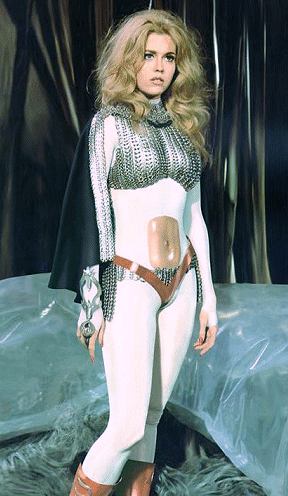 |
Barbarella ‘Barbarella’, released in December 1967, is a camp classic if ever there was one. Statuesque women in perspex bras, comic strip adventures on other worlds, fantastic landscapes, bizarre machines which cause death by ecstasy, dotty dialogue and a Candide-like heroine. ‘Barbarella’ is a film Jane Fonda may feel is merely a light-hearted romp in contrast to the serious films she is proud of – but it’s one she shouldn’t be ashamed of. As strange as it may seem, at one time Jane felt uncomfortable about her body – at least when it came to exposing it, which was inevitable when husband Roger Vadim directed her. When she began filming ‘Any Wednesday’, studio head Jack Warner said he didn’t like the size of her breasts and ordered her to wear a bra. She had observed, “When I first became an actress, I was told that I didn’t look right. That I wasn’t right. I had to dye my hair blonde. I had to wear falsies, my lips were repainted. That all helps to make your mind alienate you from what you are, not only inside, but outside". Vadim was pleased that she agreed to appear as Barbarella and said, “One of the reasons I was pleased she did it was because she was not very secure as far as her looks were concerned. She didn’t feel that she was in any way sexy. People may not believe that, but it’s true. Barbarella gave her a certain sense of confidence.” The assistant make-up man on the film began to boast widely of caressing Jane’s breasts, bottom and inside thighs as he touched up her body with paint and powder. His wife bought a gun and threatened to kill him. He retreated from the picture – and lived! Jane was to say, “The over-emphasis on identifying me with sex is pretty silly. I’m no sex siren just because I believe in approaching sex and the human body with honesty. I think the whole obsession with sex and the size of a girl’s breasts is a perversion".
Duran Duran locks her in a machine of ultimate ecstasy, the 'Orgasmatron', that kills its victims with pleasure – but Barbarella absorbs as much ecstasy as it can give and the machine eventually blows a gasket! Its erotic costumes, irreverence and sexiness helped to make ‘Barbarella’ a box office success. American critic Pauline Kael was to write, “Jane Fonda, having sex on the wilted feathers and rough scroungy furs of ‘Barbarella’ is more charming and fresh and bouncy than ever – the American girl triumphing by her innocence over a lewd comic strip world of the future". |
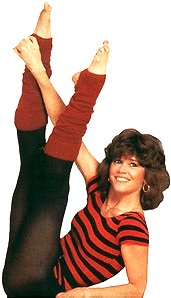 |
Jumping Jane After eventually conquering the bulimic tendencies, Jane began attending a workout run by Gilda Marx, one of the pioneers of exercise studios. As a result, Jane decided to begin her own series of aerobic exercises and founded ‘Jane Fonda’s Workout Inc’ in 1978. It made her a multi-millionairess. She opened her first studio in Wilshire Boulevard, then another in South Roberton Boulevard, near Beverly Hills, and commented, “I wanted it there so women could come in from their work, their shopping, from whatever they were doing, and do their exercise in a no-frills environment under skilled supervision". By 1983, 3,000 women a week were paying to exercise at Jane’s studios. Her first exercise book ‘The Jane Fonda Original Workout Book’ became a publishing phenomenon and sold 1,800,000 copies. Her second book, ‘Workout Book for Pregnancy, Birth & Recovery’, published in 1982, brought in royalties of more than $5 million – but she was to find an even bigger source of revenue on video cassette. Her first workout video was released in April 1972 and spent years at the top of the American video charts. It’s been assessed that her complete series of workout videos brought her an income of $70 million. The original aerobics workout was quite basic. Jane, wearing a tight-fitting leotard, began her exercises with a group of women behind her and a music soundtrack. There were critics. Professor Margaret Morse of the University of Southern California criticised the videos as being – “Almost soft-porn, complete with heavy breathing, sexy stares and lingering shots of parts of the body not directly related to the exercises". Three new best-selling videotapes were issued in 1984 and 1985 and the royalties piled up, causing her to be featured in American business magazines who praised her success as one of the nation’s foremost businesswomen. A further three videotapes were issued between 1986 and 1988 and her ‘Start Up With Jane Fonda’ had an initial order of 781, 659 units. In 1989 a further video ‘Jane Fonda’s Complete Workout’ was released. |
 |
| American
Senators demanded that she be indicted for treason when she began broadcasting
for Hanoi Radio urging American soldiers to renounce the war. By 1967 the
United States had dropped more than 100,000 tons of napalm on North Vietnam,
together with more explosives than in the entire Pacific Theatre of World
War 2. Eight million peasants had been herded into barbed wire camps patrolled
by political police in the South. There had been enough poisonous chemicals
used to defoliate and sterilise 10,000 acres of farmland and half a million
Vietnamese men, women and children had been killed. President Nixon, who’d originally promised to end the war, had escalated the bombing and had called American protesters ‘bums'. In May 1970, in an address to an anti-war demonstration in Washington D.C., Jane Fonda had begun a speech with the words, “Welcome, fellow bums". Jane visited North Vietnam in July 1972 to inspect the ruined buildings, hospitals, refugee areas and prisoners of war and made ten broadcasts over Radio Hanoi urging American soldiers to renounce the war. She was labelled ‘Hanoi Jane’, called a ‘pinko slut’ and Senators demanded that she be indicted for treason. Members of the Congress called for her prosecution as a traitor. At a press conference before hostile reporters in Paris, following her Vietnam trip, she said, “What is a traitor? I cried every day I was in Vietnam. I cried for America. The bombs are falling on Vietnam, but it is an American tragedy”. She said that Vietnamese prisoners had been tortured and thrown out of planes and insisted that the Vietnamese didn’t torture American prisoners. In Sweden, during an anti-war march, a woman poured a can of red paint over her head. Various American city councils recommended she be censured for her charge that returning prisoners of war were lying about their torture at the hands of the Vietnamese. One Congressman called her performance in Vietnam, “the rottenest, most miserable performance by any one individual American in the history of our country". |
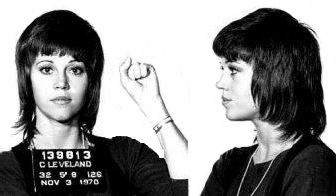 |
 |
She
did seem to accept everything the Vietnamese told her without question,
even accepting their figure that there were only 300 American prisoners,
which was completely untrue. It transpired that the prisoners were tortured
and inhumanely treated in the notorious ‘Hanoi Hilton'. Colonel George Day,
Senior Officer at the ‘Hanoi Hilton’, commenting on the broadcasts, said,
“It is difficult to put into words how terrible it is to hear that siren
song that is so absolutely rotten and wrong. It was worse than being manipulated
and used. She got into it with all her heart. She wanted the North Vietnamese
to win. She caused the deaths of unknown numbers of Americans by buoying
up the enemy’s spirits and keeping them in the fight. That’s not what you
expect from Henry Fonda’s daughter". The Vietnamese arranged a press conference for her with the prisoners. Those who refused were tortured. Colonel Day, who’d been kept in solitary confinement for 37 months, refused to see her and as a result was flogged until his buttocks were like hamburger. Another prisoner who refused to see her and quote from prepared scripts was forced to kneel on a cement floor with a steel rod in front of him for two days and each time the rod dipped he was beaten brutally. When he returned home a few years later, part of his foot was missing. It was also claimed that a captured pilot was executed because he refused to be part of the orchestrated conference. Eight POWs eventually agreed to meet her for the propaganda exercise. One, Lieutenant Commander David Hoffman, had initially refused. His arm was broken and then yanked until he agreed. He said, “I was hung by that broken arm several times and allowed to drop, at the end of a rope, from a table which was kicked out from under me. “If Miss Fonda feels for a minute that any of the people she saw were able to speak freely and were not fully aware that any deviation from what we were told to say or could say would bring instant punishment the minute she departed then she’s got another think coming. I reject everything I said during the press conference with Jane Fonda". In the late Seventies Jane was to make one of the first films about the consequences of war, ‘Coming Home', which was totally sympathetic to the American veterans who had been killed or crippled by it. |
|
Article
Text
UK
web hosting by
|